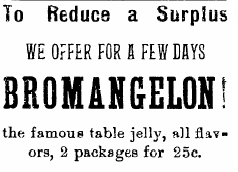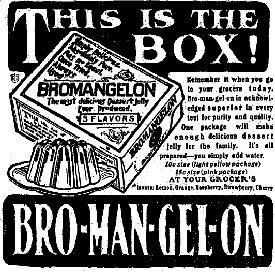
Bridgeport (Conn.)
Telegram, March 26, 1920

Above:
Middletown (N.Y.)
Daily Argus
May 2,1896.
At right: Fort Wayne, Ind. News, Feb. 23, 1906

Thursday, April 14, 2005
Page 15
REMINISCING (Column)
Jell-O of the Early 1900s Faces Competition
By ROGER M. GRACE
When the Genesee Pure Food Company of Le Roy, New York in 1900 launched a campaign to promote its recent acquisition, Jell-O—developed three years earlier by a carpenter/medicine-maker—it faced close competition from a like New York product which apparently had an earlier start.
Virtually everyone today is familiar with Jell-O (often spelled Jello). Yet, that brand of powdered dessert gelatin was, in the early 1900s, no better known than the E.S. Burnham Company’s Hasty Jellycon (or Jelly-Con), now extinct and relegated to oblivion.
Jell-O started out with four flavors: orange, lemon, strawberry, and raspberry. Jellycon topped that. It had those flavors, plus wild cherry and peach.
Additionally, Jellycon offered “calf’s foot” gelatin, undoubtedly patterned after the unflavored Knox “Sparkling Granulated Calves Foot Gelatine” which originated in Johnstown, New York in or about 1894. (The Knox brand is still on the market, and still uses the British spelling of gelatin with an “e” at the end, though it has long abandoned reference to calves’ feet and is denominated simply “Knox Original Gelatine.”) Jellycon’s “calf’s foot” variety was recommended for use in preparing coffee or wine jelly.
While the word “jelly” is part of “Jellycon,” the product was an analogue of Jell-O, not just a mix for making jelly. Ads—such as one in the Bangor (Maine) Daily Whig and Courier on Jan. 19, 1898—declared that Jellycon was designed “for the immediate production of a delicious and tempting Dessert” or “Table Jelly.” By the same token, Jell-O’s 1908 trademark covers a “compound used in the preparation of jellies….”
The distinction between jelly and dessert gelatin was not so well defined back in those horse-and-buggy days. We picture Jell-O (or other instant gelatin) as having freshly emerged from the refrigerator in which it was placed to set. Yet, in the early 1900s, there were no electric or gas-powered refrigerators, and instructions for preparing instant gelatin desserts called for adding hot water and letting the substance set in some “cool” place.
Ads for Jell-O placed in various newspapers in 1900 and 1901 were headed:
“What Shall We Have for Dessert?”
They continued:
“This question arises in the family every day. Let us answer it to-day. Try Jell-O, a delicious and healthful dessert.”
Counter advertisements by Jellycon were headed, “Do You Know” and declared:
“Burnham’s Hasty Jellycon will satisfactorily answer the question: ‘What shall we have for dessert today?’ ”
An Oct. 10, 1915 ad for Jellycon in the Elyria (Ohio) Evening Telegram proclaimed:
“JELLYCON is the PIONEER of all jelly powders.
“JELLYCON has been on the market for thirty-two years; continually produced by the originators, so constantly improving it till they have earned for JELLYCON, the well-deserved title of ‘Jelly Powder of Purity and Merit.”
That would set the founding date at 1883. It’s curious that ads for Burnham’s Clam Boullion were often found in newspapers in the mid-1880s, but made no mention of Burnham’s Hasty Jellycon. A grocer’s ad in the North Adams (Mass.) Transcript on March 3, 1898, described “JELLYCON TABLE DESSERT” as “Something New.”
From this, one might speculate that Jellycon actually got its start later than 1883—and perhaps after Pearle Wait started peddling his invention Jell-O door-to-door in 1897. However, the fact that an ad describes a product as “new” does not necessarily mean it made its first appearance quite recently. Ads for Jell-O in 1900 described the product as “The New Dessert.”
And then there was Tryphora, its founding date unknown. However, there was an ad in The Fitchburg (Mass.) Sentinel on March 15, 1897 offering it for sale at Joslin’s for 9 cents a package. It was billed as “A delicious JELLY dessert made instantly.” An ad in the same newspaper on Aug. 8, 1900 specified the flavors:lemon, orange, raspberry, strawberry and wild cherry. A Washington Post ad on May 23, 1907 described it as “the quick and satisfactory gelatine” and specified: “Comes in all the fruit flavors, several wines and mint.”
Manufactured by E.C. Rich, Inc. of New York, its sales appear to have been mostly in east coast stores.
|
|
|
|
At right: Fort Wayne, Ind. News, Feb. 23, 1906 |
|
Bromangelon, on the other hand, was sold nationally. Its founding date also is not readily ascertainable but was no later than 1896. An ad in the Middletown (N.Y.) Daily Argus on May 2, 1896 for Ready Pay Store offered Bromangelon, “the famous table jelly, all flavors, two packages for 25c.”Advertising in 1900 shows it came in the same flavors as Tryphora, except cherry Bromangelon wasn’t “wild.”
By 1930, Tryphora and Bromangelon were off the market, and Jellycon was readying to depart. But Jell-O had new competitors. More on that next week.
Copyright 2005, Metropolitan News Company
MetNews Main Page Reminiscing Columns